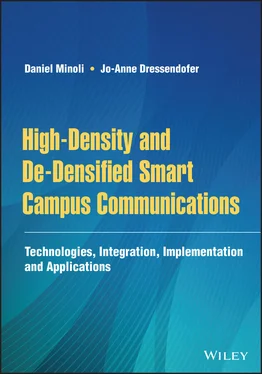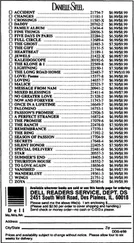1 ...6 7 8 10 11 12 ...23 TABLE 1.4 Largest US Football Stadiums
| Rank |
Stadium |
Seating Capacity |
Location |
| 1 |
Michigan Stadium |
115 000 |
Ann Arbor, Michigan |
| 2 |
Beaver Stadium |
111 000 |
University Park, Pennsylvania |
| 3 |
Kyle Field |
111 000 |
College Station, Texas |
| 4 |
Ohio Stadium |
110 000 |
Columbus, Ohio |
| 5 |
Neyland Stadium |
109 000 |
Knoxville, Tennessee |
| 6 |
Rose Bowl |
107 000 |
Pasadena, California |
| 7 |
AT&T Stadium |
105 000 |
Arlington, Texas |
| 8 |
Darrell K Royal–Texas Memorial Stadium |
104 000 |
Austin, Texas |
| 9 |
Tiger Stadium |
102 000 |
Baton Rouge, Louisiana |
| 10 |
Bryant–Denny Stadium |
102 000 |
Tuscaloosa, Alabama |
TABLE 1.5 Top Convention Centers in the United States
| Center |
Location |
Exhibition Space, Approx. (ft 2) |
Total Space, Approx. (ft 2) |
| McCormick Place |
Chicago, Illinois |
2 700 000 |
9 000 000 |
| Orange County Convention Center |
Orlando, Florida |
2,100 000 |
7 000 000 |
| Georgia World Congress Center (GWCC) |
Atlanta, Georgia |
1 500 000 |
4 000 000 |
| Las Vegas Convention Center |
Las Vegas, Nevada |
2,200 000 |
3,200 000 |
| New Orleans Morial Convention Center |
New Orleans, Louisiana |
1,100 000 |
3,100 000 |
| America's Center |
St. Louis, Missouri |
500 000 |
2 700 000 |
| San Diego Convention Center |
San Diego, California |
600 000 |
2,600 000 |
| TCF/Cobo Center |
Detroit, Michigan |
720 000 |
2 400 000 |
| Walter E. Washington Convention Center |
Washington, DC |
700 000 |
2 300 000 |
| Sands Expo and Convention Center |
Las Vegas, Nevada |
940 000 |
2 300 000 |
Some events comprise both a set of lecture sessions and exhibit sessions. When lecture sessions are underway, the connectivity requirements (specifically, the traffic volume density) may be low or lower; however, when the sessions wrap up, there may be a pulse‐shaped traffic requirement where a large number of participants all want to make phone calls or access the Internet.
There are about 310 convention centers in the United States of various sizes, 50 of which have more than 200 000 ft 2of total space. See Table 1.5for the top 10 convention centers in the United States. For example, the largest US convention center is the McCormick Place in Chicago, Illinois, with 9 million ft 2of space and 2.7 million ft 2of exhibition space. The exhibit space generally tends to be one‐half to one‐third of the total space.
1.2.4 Pre‐pandemic/Long‐term Requirements for Open Air Gatherings and Amusement Parks
Networks for public parks are typically designed around public safety and the availability of cellular service; first responder access is important (e.g. in the context of E911). For data and multimedia services, users will typically utilize their smartphones and 4G/LTE cellular connections; however, in some instances, Wi‐Fi is available, as in the latter case, and is employed to move users toward food and merchandize concessions, or for geo‐fencing applications. A target of one million connections per square kilometer (also definable as 1 connection per m 2or 1 connection every 10 ft 2) has been suggested by some researchers [2]. Open air gathering tends to be more “pop up” operations with short‐lived operational timeframes; however, the density could be high, even multiple individuals (say 2–3) every 10 ft 2. Requirements include high‐capacity data and video access, and perhaps video surveillance.
TABLE 1.6 Top Amusement Parks in the United States
| Site |
2017 Visitors |
| 1. Magic Kingdom, Lake Buena Vista, Florida |
20 450 000 |
| 2. Disneyland, California |
18 300 000 |
| 3. Disney's Animal Kingdom, Florida |
12,500 000 |
| 4. Epcot, Florida |
12,200 000 |
| 5. Disney's Hollywood Studios, Florida |
10 722 000 |
| 6. Universal Studios, Florida |
10 198 000 |
| 7. Disney California Adventure |
9 574 000 |
| 8. Universal's Islands of Adventure, Florida |
9 549 000 |
| 9. Universal Studios, Hollywood |
9 056 000 |
| 10. Knott's Berry Farm, California |
4 034 000 |
A lower target seems appropriate for amusement parks, given that people go to these parks (usually with high entrance fees) for entertainment and less for spending time on personal communication devices. There are about 430 parks and amusement parks in the United States; Table 1.6identifies the 10 top parks.
1.2.5 Pre‐pandemic/Long‐term Requirements for Classrooms
Classrooms are in session only for certain hours of the day, of the week, of the seasons. Students may toggle between being online and listening to the teachers. In broad terms, a classroom (say of 40 × 40 ft and 32 students) would require one connection every 50 ft 2.
There were 132 853 K‐12 schools in the United States in 2015, according to data from the National Center for Education Statistics (NCES). The average public school size is as follows: city: 591 students; suburban: 656 students; and rural: 358 students. Table 1.7depicts the enrolment in the top 10 districts in the United States.
TABLE 1.7 Enrolments at Largest US Districts
| Rank |
District Name |
State |
Enrollment (K) |
| 1 |
New York City |
NY |
1100 |
| 2 |
Los Angeles Unified |
CA |
634 |
| 3 |
Chicago |
IL |
378 |
| 4 |
Miami‐Dade County |
FL |
357 |
| 5 |
Clark County |
NV |
327 |
| 6 |
Broward County |
FL |
272 |
| 7 |
Houston |
TX |
216 |
| 8 |
Hillsborough County |
FL |
214 |
| 9 |
Orange County |
FL |
200 |
| 10 |
Palm Beach County |
FL |
193 |
TABLE 1.8 Example of School Demographics (NYC)
| Size Category |
Number of Classrooms |
Number of Offices |
Total Building Area (ft 2) |
Approximate Number of Sites |
| Small |
50 |
10 |
100 000 |
250 |
| Medium |
100 |
15 |
175 000 |
650 |
| Large |
140 |
25 |
300 000 |
275 |
| Campus |
200 |
40 |
450 000 |
100 |
|
|
|
|
1275 |
A school may have a large number of classrooms, in addition to administrative offices. For example, New York City's Department of Education (DOE) is the largest school system in the United States, serving over 1.1 million children across 1800 schools with 140 000+ employees at 1300+ school buildings and 29 administrative sites across New York City. Many sites have multiple schools or administrative offices per building. While individual schools vary greatly in size, a standard set of LAN/WAN equipment, including switches, routers, servers, firewalls, and access points is deployed throughout individual school organizations and shared spaces. These networks provide e‐mail, administrative and instructional applications for both wired and wireless devices. Additionally, administrative networks are typically wired and are kept in separate VLANs from instructional networks. Table 1.8illustrates the approximate size and demographics for New York City DOE School buildings.
Читать дальше












